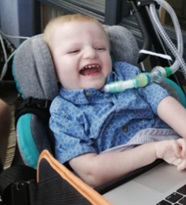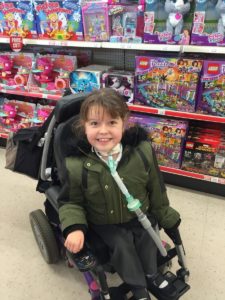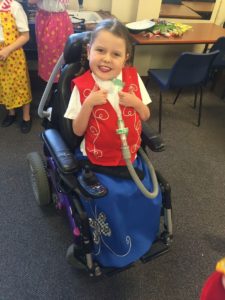Families’ Experiences of Spinal Muscular Atrophy with Respiratory Distress 1
Families’ Experiences of Spinal Muscular Atrophy with Respiratory Distress 1
With SMARD1 a child’s symptoms are often in reverse to SMA Type 1, with breathing difficulties appearing before muscle weakness.
Doctors may have had to intervene to help the child with these breathing difficulties before they know exactly what is causing them. They may or may not suspect SMARD1 at this stage.
With SMARD1 there is a wide range of severity. Some children are very weak and some stronger. Because every child is different, what is the appropriate medical management for one is not always appropriate for another. Each family’s wishes in terms of a care path for their child may be very different. Care and management can be very complex and potentially difficult and distressing. The children’s medical team will always involve parents in discussions and any decisions.
Our thanks to the families who have shared their very personal experiences of caring for their children. If you have any questions, please get in touch with our Support & Outreach Team.
First published: 14th September 2020
 Lex was 14 months old when he suddenly stopped breathing in his mother’s arms, had 4 heart attacks and a stroke.
Lex was 14 months old when he suddenly stopped breathing in his mother’s arms, had 4 heart attacks and a stroke.
Lex spent 8 months fighting in hospital. There is little known about SMARD1, and we were told there was no cure, and to prepare for end-of-life care. Luckily, we met other families from smashSMARD, the only charity to fund SMARD1 research. These wonderful families showed us that there was so much hope out there for our little guy.
We finally managed to get Lex home and he is now under excellent hospital and home nursing care. He needs a tracheostomy and lots of machines to live with SMARD1, but never stops smiling, laughing, and bringing joy to everyone who knows him. Our lives are very different, but very happy. We’ve had lots of intense medical training and have to keep learning and working hard every day to keep Lex safe and healthy. He has a nurse with him every night and four days a week. The nurses during the day have extra training so they are able to care for Lex while we both continue full-time employment at a university that has been extremely supportive throughout our family’s journey. Lex is an amazing and truly happy little boy. He has a tremendous quality of life.
As SMARD1 is classified as an “ultra-rare” disease, if your child has SMARD1 we ask that you please register your child in the National Organization for Rare Disorders (NORD) SMARD1 registry: https://smard1.iamrare.org as this official registry is critical in supporting potential treatments/cures that can help all of our amazing SMARD fighters around the world.
You can read more about the fundraising Lex’s family are doing for gene therapy via smashSMARD.
First published: January 2011
 Maddison was born full term weighing a healthy 7lb 13oz. She is the youngest of 4 children. The only symptom she had when she was born was club foot, but we were reassured that it was positional and with physiotherapy could be corrected.
Maddison was born full term weighing a healthy 7lb 13oz. She is the youngest of 4 children. The only symptom she had when she was born was club foot, but we were reassured that it was positional and with physiotherapy could be corrected.
From birth to 6 months we noticed that Maddison had a very quiet cry, but again were reassured it was nothing to worry about.
At 6 months old Maddison took really poorly with a respiratory infection. Over a period of 4 months Maddison was in hospital undergoing lots of intense tests including a muscle biopsy, nerve conduction, blood and genetic tests, lumbar punctures.
At 9 months old we were given the devastating news that Maddison had SMARD1!!!! Everything was all very negative, they said she’s unlikely to live past 2 years and if she did live she would have no quality of life. They went on to say she would never sit, eat, talk or breathe unaided, ever.
At 10 months Maddison had her tracheostomy and was put on a ventilator. With Maddison being fully ventilator dependent we needed to get trained to look after her. Also a care plan needed putting in place, we got 7 awake nights and 45 hours day care from the NHS. Both me and dad had to stop work because Maddison needed 2 carers at all times.
 From coming out of hospital at 16 months Maddison thrived. She’s now 8 and has never been back in to hospital. She can now come off her ventilator up to 5 hours a day, she can also sit, bottom shuffle, eats orally, talks completely normally and has a fantastic quality of life.
From coming out of hospital at 16 months Maddison thrived. She’s now 8 and has never been back in to hospital. She can now come off her ventilator up to 5 hours a day, she can also sit, bottom shuffle, eats orally, talks completely normally and has a fantastic quality of life.
Maddison attends mainstream school 5 days a week. She goes to Brownies, stage school, and wheelchair football. She is confident, clever and very inspirational. She recently received an ‘inspirational child award’ from Prince Harry.
We’re very proud of her xx